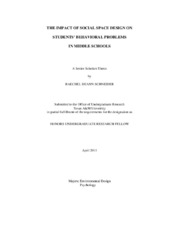| dc.contributor.advisor | Zhu, Xuemei | |
| dc.creator | Schneider, Raechel | |
| dc.date.accessioned | 2011-08-08T22:48:51Z | |
| dc.date.accessioned | 2011-08-09T01:21:35Z | |
| dc.date.available | 2011-08-08T22:48:51Z | |
| dc.date.available | 2011-08-09T01:21:35Z | |
| dc.date.created | 2011-05 | |
| dc.date.issued | 2011-08-08 | |
| dc.date.submitted | May 2011 | |
| dc.identifier.uri | https://hdl.handle.net/1969.1/ETD-TAMU-2011-05-9645 | |
| dc.description.abstract | This study examined the impact of social space design on student behavioral problems in middle schools. A mixed-method approach was used in the form of focus groups and surveys with teachers and students from four central Texas middle schools (7th and 8th grade). Social space was defined as any space that students use while not in the classroom (e.g., hallways, cafeteria and outdoor spaces). Negative behavioral patterns were defined by the schools themselves but typically were any act that is physically or emotionally harmful to another student, oneself, or school property (e.g., stealing, fighting and name-calling). For each space, design elements that were analyzed included seating, privacy, equipment, structure, and open space. Within one school, four key spaces were identified and students were surveyed regarding their opinions of the design and behavioral patterns within each space. Comparisons across spaces within and among the four schools showed areas that are overcrowded or lack supervision exhibit higher accounts of negative behavior. Structured social spaces and outdoor spaces have less instances of problematic behavior but only when overcrowding is not a problem. This study also uncovered design factors that were important to the students but were not originally considered such as their desire for safety. This result highlights the importance of student voice in design. Overcrowding, supervision and the balance of privacy and safety emerged as the main issues regarding social space design and behavioral patterns in middle schools. | en |
| dc.format.mimetype | application/pdf | |
| dc.language.iso | en_US | |
| dc.subject | education, design, socialization, social spaces, overcrowding, supervision, privacy, middle schools | en |
| dc.title | The Impact of Social Space Design on Students’ Behavioral Problems in Middle Schools | en |
| thesis.degree.department | Architecture | en |
| thesis.degree.discipline | Architecture | en |
| thesis.degree.grantor | Texas A&M University | en |
| thesis.degree.name | Bachelor of Environmental Design | en |
| thesis.degree.level | Undergraduate | en |
| dc.contributor.committeeMember | Hull, Rachel | |
| dc.type.genre | thesis | en |
| dc.type.material | text | en |


